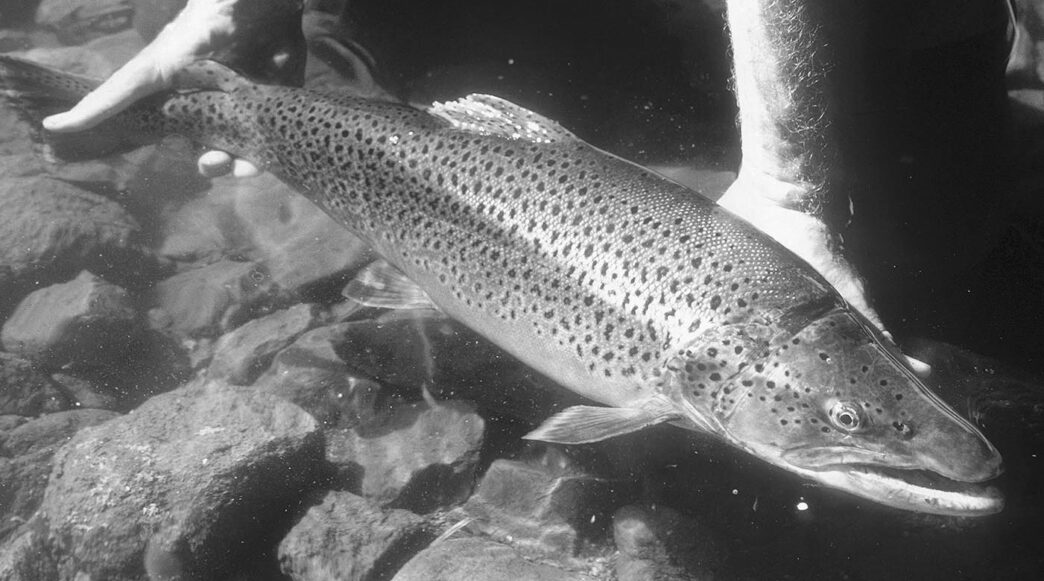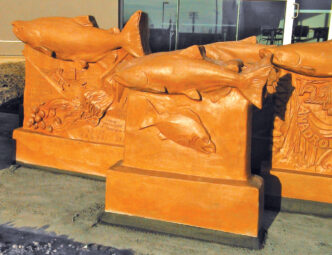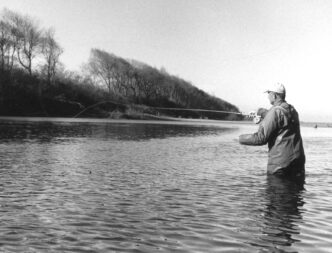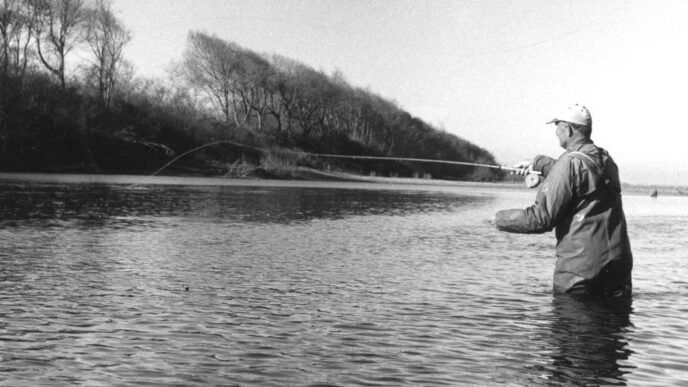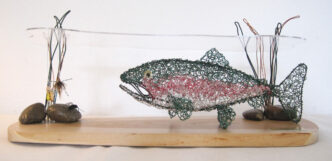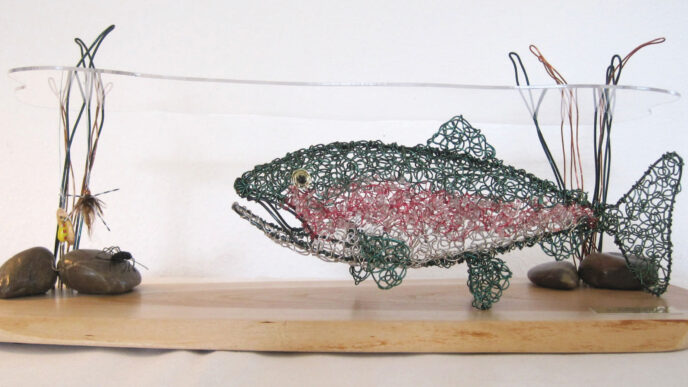Brown trout are the real deal, They don’t pretend to be some flashy “New Age” trout, like the goldens and cutthroats. Browns are the original trout from the original genus Salmo, named by none other than Linnaeus himself. Brook trout, rainbow trout, speckled sea trout, and so on, can claim to be trouts, but they aren’t Salmo.
Browns are no less “nonnative, invasive species” than star thistles, Scotch broom, quagga mussels, and Nestlé. They don’t care. Browns are kissing cousins of the Atlantic salmon, Salmo salar, which means “the jumper,” yet they don’t jump — unless, of course, they choose to. Unlike a whitefish (which we all know “can’t jump”), a brown trout can stuff the ball behind its head when the time and place suits it, but normally, it’ll be content to keep the game close to the boards.
Brown trout didn’t just hitch a ride up the hill in milk cans, like the rainbows, nor did they merely cross the Continental Divide, like the brook trout. They motored all the way across the Atlantic from Europe and didn’t even have to wag a tail. They took a boat.
In 1883, some eighty thousand brown trout eggs were packed in wet moss and shipped from Berlin to America. A year later, another boatload of eggs was shipped across the pond from Germany. These became the progenitors of our modern-day “German” browns. The shipments were facilitated by the president of the German Fish Culturists Association, Friedrich Felix von Behr, and in his honor, people of the day insisted on calling these fish “von Behr” trout.
In late 1884, another ship arrived, laden with fertile brown trout eggs from the Loch Leven region of Scotland. Within a few decades, the “Loch Leven” and “German” brown trout had been planted across the nation. In the process, the strains were repeatedly intermixed, and today, any distinctive features of regional fish are likely based on inbreeding and local environmental influences, rather than lineage. Except in Lewis and Shoshone Lakes in Yellowstone, where pure Loch Levens were stocked once and no browns were ever stocked again, today’s “German” brown could just as easily be called a “von Behr” trout or a Loch Leven. They’re all one and the same.
Despite their name, brown trout run the color gamut from the bright pewter found in individuals dwelling in deep lakes to hues of green, yellow, brown, and red. Browns can immediately be differentiated from rainbows because they lack spots on the tail. Browns are the only trout in California that have both red and black spots on the body. Even the tiniest fry usually has a red spot on the adipose fin.
Within 50 years of their introduction, brown trout had become a scourge to resource managers and anglers alike. Resource managers considered them a blight because of their decidedly fish-oriented diet. Dumb hatchery rainbows provided an excellent food source for the fish. Browns displaced rainbows and cutthroats on many of the smaller streams they coinhabited. On larger rivers, though, the fish populations tended to sort themselves out, because browns prefer banks, deep pools and cover, while rainbows have a preference for riffles, channels, and runs.
On Pacific Coast rivers, salmon and steelhead have held their own against browns, but as anadromous populations decline, it might be expected that California will experience an uptick in the populations of coastal brown trout. Sea-run browns are fantastic fish, but to have them fill the gap created by loss of our native stocks would be a shame.
Where browns and rainbows coexist, the brown trout typically outnumber the rainbows, yet constitute only a fraction of the catch. Where populations are equal, generally three rainbows are caught to every brown. As their size increases, the disparity only grows. Population estimates based on creel censuses can severely underestimate the percentage of brown trout.
Browns are tough to catch for a number of reasons. During their first few years, they eat the same bugs and crustaceans that rainbows do, and nymphs and dries imitate their foods just fine. As they grow larger (at about 14 inches on the Truckee), their primary diet abruptly shifts to crayfish and fish. The typically presented nymphs and dries simply don’t appeal to them as much as they do to rainbows. Also, since the meals are substantially larger and take longer to digest, browns don’t have to take as many bites of food as other trout. Fewer bites means fewer opportunities to add a hook to the meal.
Browns have exceedingly good eyesight in the low-light conditions during which they prefer to feed — much better than any other trout. Where a rainbow might discern a fuzzy shape in dim or murky waters, the rod-packed retina of the brown trout allows it to view its prey in great detail. This extraordinary night vision allows browns to feed well past the hours when most anglers are back at the bar.
Once eagerly planted across the nation, browns are no longer stocked in many waters, and in some places are even being removed. One of my earliest recollections of brown trouticide was a pile of huge fish corpses lined up on the shore of Convict Lake. It was a Department of Fish and Game photo of a gill-netting operation to rid the lake of the voracious trout that ate expensive planters. I was (and 40 years later still am) totally perplexed why anglers weren’t shunning the planters and going after these browns exclusively. I dreamed of catching one of those monsters and even ordered a kit from the Herter’s catalog to build my own gill net. Fortunately for those trout, weaving a 20-foot net was too boring for a hyperactive 10-year-old, and even if gillnetting trout had been legal, my parents probably wouldn’t have driven me down there anyway.
The brown’s reputation as a piscivore (fish eater) is deserved, but it doesn’t eat any more of its finny neighbors than a brook trout or bull trout. I believe that when given the opportunity, a brown is just as inclined to devour a crayfish as it is a trout and even more inclined to eat a slow-moving sculpin. They are well known for eating soft, furry mammals, too.
While my friends were ogling the women’s underwear ads in the Sears catalog, I was getting my childhood porn from Field & Stream magazine. I read and reread an article about anglers in Alturas who would fish for monster browns in the headwaters of the Pit River by lashing treble hooks to mice with pipe cleaners, then sending them floating downstream on a shingle. At the right spot, they would jerk the little rodent from its raft and let it swim for shore. Football-sized browns would rise from the depths and flatten the mice with the eagerness and ferocity of a Rottweiler on a dachshund in heat.
With fly rods and floating mouse patterns there is no need for shingles, pipe cleaners, and treble hooks. A long downstream drift, followed by a swing into the bank, then a furious twitch, twitch, twitch works even better.




